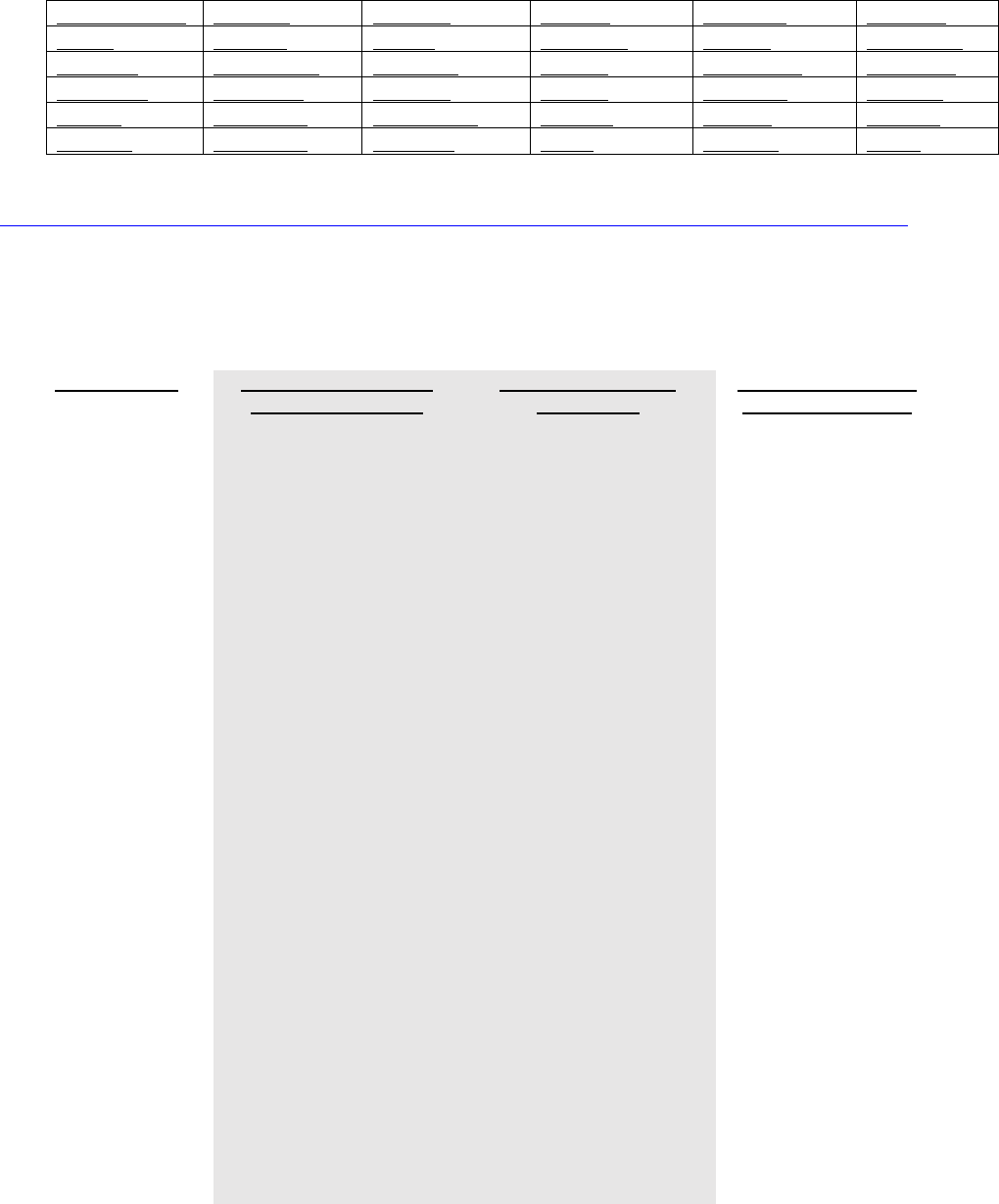
1
WCU Writing and Learning Commons (WaLC)
APA- Research Documentation
American Psychological Association
Belk 207
https://tutoring.wcu.edu
227-2274
Call, visit us, or go online to
make an appointment
This handout is designed to give you quick assistance with using APA rules for undergraduate papers at WCU.
The information presented here is based on the Publication Manual of the American Psychological Association,
6
th
edition, 3
rd
printing (Washington DC: APA 2009). We strongly encourage you to consult this manual for
detailed questions. You can find a copy in the Writing and Learning Commons (Belk 207) and at Hunter Library’s
Reference Desk, or you can purchase your own copy from any bookseller. There are also many examples and
detailed explanations on the APA website: http://www.apastyle.org
What is APA?
“APA style” is the recognized style of the American Psychological Association. APA is used primarily in the
social sciences, but it is common in many classes at WCU. APA guidelines cover more than just citations; APA
provides rules on the structure, style, and look of a paper, including headings, tables, and research methods.
Formatting Your Paper
Use 1-inch margins on all sides. APA recommends 12-point Times New Roman font.
Title Page
The Content/Body
Sources page
Running head: SHORT TITLE 1
Title of Paper
Your Name
Western Carolina University
SHORT TITLE OF PAPER 2
Title of Paper
Text begins here. Double space,
use 12 point Times New Roman or a
similar font, and indent new paragraphs
½”. Margins should be 1” all around,
with the header ½” from the top. For
more samples of APA papers, stop by the
WaLC.
Section Heading
Level 2 Heading
Level 3 heading.
level 4 heading.
See the explanation below for
information on how headings work in
APA. If your paper has multiple sections,
you will need to format them properly.
References
Author, A. A. (Year). Title of work.
Location City, State or Country:
Publisher.
Author, B. B. (Year). Title of work.
Location City, State or Country:
Publisher.
2
The Title Page (See APA Manual p. 23)
A title page in APA should establish the “running head” and provide the page number, title, your name, and the
class (and/or university) for which you wrote the paper. Some professors may ask you to include the date.
Graduate-level papers and/or papers being submitted for publication may require an author’s note. Information
on author’s notes can be found in the APA manual.
The Abstract (See APA Manual p. 25)
An abstract is a summary of your paper. For most undergraduate papers, abstracts are not required. Ask your
professor whether to include one. If you are required to write an abstract, it should appear on the second page, in
block format, and be 150 to 250 words in length. For more information, consult the APA manual or visit the
WaLC.
The Content/Body (See APA Manual pp. 42-47)
After the title page (and the abstract, if you’ve been required to write one), your paper begins. Each page of your
paper should have a running header and page number and should follow APA’s formatting rules for headings,
tables, etc. Note that the header on the title page is not the same as the header in the rest of the paper.
Headings (See APA Manual p. 62)
APA recommends using headings to separate sections of a paper. Headings are particularly important in studies,
proposals, and reports. The rules for headings in APA relate to the “level” of the section. In order to make sure
you use headings effectively, try outlining your paper, or prioritizing ideas in your draft. It should be easy to tell
major elements from minor points. If you use headings, format them according to these rules:
Level 1: Centered, Bold, Major Words are Capitalized
Begin body text on the next line. Level 1 headings are sections like Methods, Results, and major elements. The
title of the paper does not count as a heading. The term “Introduction” should not be used as a heading.
Level 2: Left Aligned, Bold, Major Words are Capitalized
Begin body text on the next line. Level 2 headings are used for important/common subsections, such as
the “Participants” in a Method (Level 1) section.
Level 3: indented, bold, lowercase, with a period. Begin body text after the period. Level 3 headings
are part of the text of the paragraph. Only the first word is capitalized, as it would be in a new sentence.
Level 4: indented, bold, italicized, lowercase, with a period. Begin body text after the period. Level 4
headings are not very common in undergraduate and/or short papers.
Level 5: indented, italics, lowercase with a period. Begin body text after the period. Level 5 headings
are rarely needed in undergraduate and/or short papers.
Tables and Figures (See APA Manual p. 125, 150)
APA has very specific rules for visuals and tabulated data. For information regarding the design and the proper
citation of tables, figures, or any other visual elements in your paper, refer to Chapter 5 of the sixth edition of the
Publication Manual of the American Psychological Association.
3
Rules for References
NOTE: Good research requires you to select your sources carefully and read them closely. Start by finding
reliable, relevant sources. Develop an understanding of your topic, build your source list, and then start writing.
Remember, the research always comes first! All sources should be included in a list at the end of your paper.
• Include a digital object identifier (DOI) if you have one. If not, APA prefers a link to the journal’s
homepage over the incredibly long URLs from databases. If no online journal link is available, the
databases should give you a fixed URL or permalink to the article; provide that one instead. You can also
provide a short link to the database (such as “http://eric.edu.gov”) if that is the only option available to
you. (See APA Manual p. 191)
• For online sources, provide retrieval information. Only use the date if the data on the page is subject to
change, such as Wikis. (See APA Manual p. 192)
• For a passing reference to a web site in a text, just put the URL. No reference entry is needed. (See
apastyle.org)
• Titles of books, websites, and articles are capitalized like sentences—only the first word of the title (and
subtitle, if present) are capitalized. Periodicals are different; however, titles of journals, newspapers, and
magazines should have all major words capitalized. Proper nouns are always capitalized. (See APA
Manual p. 185)
• Center the word “References” at the top of the page, and double-space all entries. (See APA Manual p.
192)
• Use a final period at the end of each entry, EXCEPT when it ends with a Web address or DOI number.
(See APA Manual p. 23)
• Use a hanging indent for each entry: first line flush with the left margin, subsequent lines indented ½
inch. In Microsoft Word, hanging indents are easy to set up. Highlight your source list, click on the
Paragraph dialog box, then select “Special” under indents (or just use the ruler functions, if you know
how). (See APA Manual p. 180)
• Alphabetize the Reference list by author’s last name. (If there is no author, use the first significant word
in the title.) Multiple references by the same author are arranged by year of publication, starting with the
earliest. (See APA Manual p. 181)
• Do not include first names of authors. Use last names and initials instead. (Also, never refer to authors
by their first names in the text of your paper.) All authors’ names should appear like this: “Smith, J. A.”
See the bullet above for more information on how to alphabetize your reference list. (See APA Manual p.
184)
• Editors. Many sources will have editors instead of authors. Follow the same rules as you would for
listing authors, but remember to put “(Ed.)” after the editor’s name, or “(Eds.)” if there is more than one
editor. (See APA Manual p. 184)
• Dates are important. Use them! If a source does not have a date, use “n.d.” to indicate no date. (See
APA Manual p. 185)
• Italics. Titles of books, journals, newspapers, magazines, and websites are always italicized. Titles of
chapters and articles are neither italicized nor enclosed within quotation marks. (See APA Manual p. 185)
4
• APA does not recommend using indirect references. Whenever possible, cite the original source,
unless the source is unavailable or unusable. In the event that you do use an indirect reference, only list
the text you are working with directly in the References page. Do not list the indirect reference on the
Reference page. (See APA Manual p. 178)
• List authors in the order they appear in the original source. For two authors, separate names with an
ampersand, like this: “Smith, A. & Jones, B.P.” For three to seven authors, list in order, with an
ampersand before the last author: “Smith, A., Jones, B. P., & Clooney, G.” For more than seven authors,
list the first six, then insert an ellipsis, then the last author’s name. (See APA Manual p. 198)
• Use only the name of the publisher. Do not use terms like “Inc.” or “Company.” If a text has no
publisher (e.g., a self-published Kindle book), use the word “Author” as the publisher’s name. (See APA
Manual p. 187)
• In general it is not necessary to include database information. (See APA Manual p. 192)
• Sources: Scholarly sources are easier to cite than informal ones. If you are having trouble with a citation,
look for a more reputable source. For any academic paper, use library resources. Don't just "Google" your
topic.

5
Reference List Examples
Below are the basic formats and examples of sources often used in research papers.
Books (print) (See APA Manual p. 202)
General format
Author, A. A. (Year). Title of work. Location City, State or Country: Publisher.
Book with one author
Debo, A. (2012). The American H.D. Iowa City, IA: University of Iowa Press.
Book with an editor
Starnes, R. D. (Ed.) (2003). Southern journeys: Tourism, history, and culture in the modern
South. Tuscaloosa : University of Alabama Press.
Book with more than one author/editor
Wright, L. & Heffelfinger, E. (2010). Visual difference: Postcolonial studies and intercultural
cinema. New York: Peter Lang.
Book with more than one edition (or a reprinted book)
Martinez, D., Peterson, T., Wells, C., Hannigan, C. & Stevenson, C. (2011). Technical writing: A
comprehensive resource for technical writers at all levels (Rev. ed.) [Nook book].
Retrieved from http://www.barnesandnoble.com
NOTE: Classical works, such as the Bible or the Qur’an, should be cited in-text only!
Electronic, audio, and online books
(See “Rules for References” for more information)
General format
Author, A. A. (Year). Title of work [version or database]. Retrieved from http://www.xxxxx
Author, A. A. (Year). Title of work. doi:xxxxx
Online version of print book
Herzog, H. (2010). Some we love, some we hate, some we eat [Kindle Edition]. Retrieved from
http://www.amazon.com

6
Electronic-only book (never published in print)
Railsback, B. A going concern [Kindle Edition]. Retrieved from http://www.amazon.com
Book on CD
Woodrell, D. Woe to live on: A novel [Audio CD]. Retrieved from http://www.amazon.com
Chapter or entry in a book
General format
Author, A. B. (Year). Title of chapter/entry. In B. Editor (Ed.), Book title (pp xx-xx.). Location:
Publisher.
Chapter in a book
Kinser, B. (2003). Mark Twain, Thomas Carlyle and shooting Niagara. In D.R. Sorensen, R.L.
Tarr (Eds.) The Carlyles at home and abroad: Essays in honour of Kenneth J.
Fielding (pp. 113-124). Aldershot, Hampshire, England: Ashgate.
Entry or chapter in a book with NO AUTHOR
Deadly nightshades. (2004). Dictionary of common plants (pp. 321-327). Boston, MA: Biology
Press.
Articles in Periodicals, Scholarly Journals, Newspapers, Etc.
(See APA Manual p. 198)
General format
Author, A. A. & Author, C. C. (Year). Title of article. Name of Periodical, vol no.(issue no.), pp-pp.
NOTE: The volume number in an APA citation is an italicized digit. Do not include the term “Vol.” or
any words. Just include the number itself, in italics, after the name of the periodical. See examples below.
Issue numbers should be included depending on how the periodical paginates its publication. If a journal
continues paginating across issues, an issue number is not needed. If the journal begins each new issue
with page 1, include an issue number in your citation. Getting this right may require some research.
Consult the APA manual, or check other issues of the journal in question to determine whether issue
numbers need to be included in your citation. When in doubt, include an issue number if you have one.

7
Article in print
Mulligan, R.F. (2010). Emergent and instrumental institutions in English constitutional history.
Studies in Emergent Order, 3, 82-99.
Online article (or PDF based on a print source) with DOI (digital object identifier)
Tanner, B.R., Kinner, D.A., Griffith, A.D., Young, R.S., & Sorrell, L.M. Presence of Arundinaria
gigantea (river cane) on numerous non-wetland sites suggests improper ecological
classification of the species. Wetlands Ecology and Management, 19(6), 521-532. doi:
10.1007/s11273-011-9233-3
Online article or PDF based on a print source, without DOI
Gastle, B. (2003). Breaking the stained glass ceiling: Mercantile authority, Margaret Paston
and Margery Kempe. Studies in the Literary Imagination, 36(1), 123-147. Retrieved from
http://www.sli.gsu.edu
Article in an Internet-only newsletter
Tate, T.K. (2013, July 9). Student studies songbird mating, personality and paternity on campus.
The Reporter. Retrieved from http://thereporter.wcu.edu
Online article with no author
Women's basketball named to 2012-2013 WBCA Academic Top 25. (2013, July 13). Western
Carolina: The official site for Catamount Athletics. Retrieved from
http://www.catamountsports.com
Online article with no author and no date (e.g., wiki article)
Wild Bill. (n.d.). In Wikipedia. Retrieved January 18, 2010, from
http://en.wikipedia.org/index.phptitWBil078
Entry in an online dictionary or reference work, no date and no author identified
Augury. (n.d.). In Merriam-Webster's online dictionary (12th ed.). Retrieved from
http://merrweb.com/augury
8
Reviews (See APA Manual p. 208)
General format
Lastname, A. A. (Year). Title of review [Review of the book Title of book, by A. A. Bookauthor]. Title of
Periodical In Which Review Appears, xx(xx), pp-pp.
Example
Cruz, L. (2013). Taxation and debt in the early modern city. [Review of the book Taxation and debt in the
early modern city, by J.I.Andrés Ucendo and M.Limberger, eds.] Economic History Review,
66(2), pp.672-673.
Government, Corporate, and Technical Reports (See APA Manual p. 205)
General format
Author, A. A. (Year). Title of work (Report No. xxx). Location City: Publisher [or URL].
Example
Western Carolina University. (2012, October). 20/20 Vision Focusing Our Future. Cullowhee:
Western Carolina University.
Other Research (See APA Manual p. 206)
General format (presentation/poster)
Presenter, A. A. (Year, Month). Title of paper. Paper/poster session presented at the meeting of
Organization Name, Location.
Example
Adams, C.A. (2013, March). From Carl or Moloch to beyond: Communism and capitalism in Allen
Ginsburg's Howl. Paper presented at the Graduate Research Symposium of Western Carolina
University, Cullowhee, NC.

9
General format (thesis/dissertation)
Author, A. A. (Year). Title (Doctoral dissertation). Retrieved from Database. (Accession/Order No.)
[If unpublished: Author, A. A. (year). Title (Unpublished doctoral dissertation). Name of Institution,
Location.]
Example
Perry, A. L. (2012). Treading through swampy water: Graduates’ experiences of the post-university
transition (Unpublished doctoral dissertation). University of Canterbury, Christchurch, New
Zealand.
NOTE: The WaLC strongly discourages using online dictionaries, wikis, and quotation sites in formal
papers.
Audiovisual Sources (See APA Manual p. 209)
General format for Motion picture or documentary
Producer, A. A. (Producer), & Director, B. B. (Director). (Year). Title of motion picture [Motion picture].
Country of Origin: Studio.
Example
Diener, S. (producer) & Sholder, J. (director). (1987). The Hidden [Motion picture]. USA: Heron
Communications.
General format for Music recording
Writer, A. (Copyright year). Title of song [Recorded by B. B. Artist if different from writer]. On Title of
album [format]. Location: Label. (Date of recording if different from copyright date)
Example
MacManus, D. P. (1978). Little triggers [Recorded by E. Costello] On Trust [CD] London, UK: Stiff
Records.
General Format for Television series or broadcast
Lastname, A. (Writer), and Lastname, B. (Director). (Year). Title of episode [Television series episode].
In C. Lastname (Executive Producer) Title of show. City: Distributor or studio.

10
Example
Simon, S. (Presenter) & Rash, R. (Guest). (Feb. 16, 2013). 'Nothing Gold' stays long in
Appalachia. [Radio broadcast]. USA: NPR.
NOTE: For television, films, music, or other artistic or cultural works, cite the original or official
recording whenever possible (instead of a Youtube video or indirect source).
General format for Online slide presentation
Author, A. B.. (Year). Title of Presentation [PowerPoint slides]. Retrieved from http://www.xxxx
Example
Writing and Learning Commons (2012). Don't get testy! Improve your test preparation and test taking
strategies [PowerPoint slides]. Retreived from https://wcu.blackboard.com
General format for Audio Book
Author, A. B. (Year). Book title [Recorded by B. B. Narrator; file format]. Retrieved from
http://www.xxxx
Example
Herzog, H. (2010). Some we love, some we hate, some we eat [Recorded by M. Foster; Audible Audio
Edition]. Retrieved from http://www.amazon.com
Websites (See APA Manual pp. 187-191, 214)
NOTE: APA considers many web sources unreliable. Also, entire websites are rarely cited in APA. Instead,
specific parts/sections should be cited individually. Ask your instructor before using any non-scholarly online
source.
Author, A. B. (Date of publication). Title of document. Retrieved from http://www.xxxx
Specific section or page from a website
Belcher, D.O. (2013). Office of the Chancellor. Retrieved from Western Carolina University website:
http://www.wcu.edu/about-wcu/leadership/office-of-the-chancellor/index.asp
Section of a web site with no date and/or no author
GVU's 8th user survey. (n.d.). Retrieved August 8, 2000, from http://www.cc.gatech.edu/gvu/survey-1997

11
Online government document or report
Western Carolina University. (2012, October). 20/20 Vision Focusing Our Future. Retrieved from
http://www.wcu.edu/WebFiles/PDFs/Strategic_Plan_2020.pdf
E-mail, Interviews You Conduct, and Other Personal Communication
Do not cite in reference list.
(See APA Manual p. 179)
In text only:
(A. Author, personal communication, Month date, year.)
Example of Email discussed in text:
The director stated the results were “disastrous but inaccurate” (A. Smith, personal communication, May
28, 2009).
Online posts (internet videos, message boards, blogs, etc.)
(See APA Manual p. 214)
General Format
Author, A. A. (Year, Month Day). Post title [Description of form]. Retrieved from http://www.xxxx
Podcast
Belt, T. (2011, September 21). Cherokee Language 101. [Audio Podcast]. Retrieved from
http://itunes.wcu.edu/
YouTube video
Porter, J. (2012,November 11)."This is How We Roll" at BOA Grand National Semi-Finals [Video file].
Retrieved from http://www.youtube.com/watch?v=-itBe-21L6c
Blog post
Lee, C. (2010, November 18). How to cite something you found on a web site in APA style [Web log
post]. Retrieved from http://blog.apastyle.org
Wiki entry
Citizenship & Civility (n.d.). Retrieved July 11, 2013 from the WCU wiki:
http://fuji.wcu.edu/groups/citizenshipcivility20122013/
NOTE: Wiki entries and undated websites must include a retrieval date. APA considers wiki unreliable.
12
In-Text (Parenthetical) Citations
(See APA Manual pp. 169-192)
• All in-text citations must include the author’s name and the year the source was produced. If a sentence
contains a direct quote or paraphrase, the citation must include a page number. When the author’s name
is cited in the sentence, the date follows the name in parenthesis. When the author(s) is not named in the
sentence, the name, date and page number (if applicable) go in parentheses at the end of the sentence.
(See APA Manual p. 174)
Documentation within your paper gives credit for any direct quotations, paraphrases, or summaries from your
sources. An in-text citation functions as a short, specific credit that corresponds to an entry on the References
page, and vice versa. The position of the in-text citation shows exactly what information has come from that
source.
NOTE: All in-text citations must include the author’s name and the year the source was produced. If a
sentence contains a direct quote or paraphrase, the citation must include a page number.
There are two forms of in-text citation:
1) Author and date cited in sentence. This is recommended the first time a source is mentioned or used. See
the explanation of signal phrases below and the second column in the table on page 9. If a direct quote is being
cited, a sentence citation must be followed by a parenthetical citation with a page number or location.
• According to Stanford (1981), numerous differences are evident when participants . . .
• Rogers and Graham (1989) dispute this finding…
• Kwitzel (1976) noted that "humanistic values in literature, science, ethics and society cut across religious
commitments and are common possessions of the culture" (p. 5).
• Verbunt, Pernot, and Smeets (2008) offered that “the level … seemed best explained by their mental
health condition and less by their physical condition” (Discussion section, para. 1).
2) All citation information in parentheses. The most common type of citation. In parenthetical citations all
information appears at the end of the sentence/mention in parentheses.
• Research has shown that men and women use generic pronouns in different ways (Martyna, 1978).
• Thus, “the placebo effect disappears when behaviors are studied in this manner” (George, 1993, p. 276),
but it depends which behaviors are being studied.
Signal Phrases
In APA, signal phrases are used to introduce and discuss sources. Much like a cocktail party where you formally
introduce your guests to one another, you should introduce and discuss author(s) in the text of your paper,
particularly the first time they are mentioned or used. Consider these common signal verbs:

13
Table 1
Commonly used verbs in APA signal phrases
Acknowledged
Believed
Declared
Granted
Observed
Reported
Added
Claimed
Denied
Illustrated
Offered
Responded
Admitted
Commented
Disclosed
Implied
Pointed out
Suggested
Addressed
Compared
Disputed
Insisted
Reasoned
Testified
Argued
Confirmed
Emphasized
Negated
Refuted
Thought
Asserted
Contended
Endorsed
Noted
Rejected
Wrote
Note: Adapted from “Signal Phrases” by Capella University Writing Center, May 2009. Retrieved from
http://www.capella.edu/interactivemedia/onlineWritingCenter/downloads/handoutSignalPhrases2009.pdf
Once you have introduced your sources, follow standard guidelines for in-text citations.
Table 2
Rules for In-text/Parenthetical Citations
Type of source
First use and/or source
mentioned IN TEXT
(see #1 on page 8)
PARENTHETICAL,
first citation
(see #2 on page 8)
Parenthetical format,
subsequent citations
One work by one
author
Trawick (2010) claims…
(Trawick, 2010)
(Trawick, 2010)
One work by two
authors
Hampton and Reich (2003)
claim…
(Hampton & Reich, 2003)
(Hampton & Reich,
2003)
One work by three to
five authors
Blaylock, Javens, and
Willover (2005) claim…
[Subsequent mentions in
text can be “Blaylock et al.
(2005) claim…”]
(Blaylock, Graves, &
Willover, 2005)
(Blaylock et al., 2005)
One work by six or
more authors
Willover et al. (2010)
claim…
(Willover et al., 2010)
(Willover et al., 2010)
Group (easily
identified by
abbreviation) as
author
The National Institute of
Nutrition (NIN, 1998)
claims…
[Subsequent mentions can
use the abbreviation only:
“NIN (1998) claims…]
(National Institute of
Nutrition [NIN], 1998)
(NIN, 1998)
Group (no
abbreviation) author
Fordham University (2011)
claims…
(Fordham University, 2011)
(Fordham University,
2011)

14
Author is missing
Title of Book or “Title of
Article” (2001) claims…
(Title of Book or “Title of
Article,” 2001)
(Title of Book or “Title of
Article,” 2001)
Date is missing
Wilber (n.d.) claims…
(Wilber, n.d.)
(Wilber, n.d.)
Author and date
missing
Title of Book or “Title of
Article” (n.d.) claims…
(Title of Book or “Title of
Article,” n.d.)
(Title of Book or “Title of
Article,” n.d.)
NOTE: Adapted from “Table 5.16. Sample Word Table” by the American Psychological Association, 2010,
Publication Manual of the American Psychological Association, sixth edition, p. 177. Copyright 2010 by the
American Psychological Association.
NOTE: If you use a direct quote or paraphrase from any source, the in-text citation must include a page
number. For example: Costello (2004) claimed that punk rock had had a “long honeymoon” (p. 75). Thus,
other musicians felt “the need for darker beats” was ongoing (Cobain, 1991, p. 23).
Exceptions to In-text Citation Rules
1) Direct quotes. If you are citing a direct quote, the in-text citation must include a page number (or a location,
if the original source is not paginated).
2) Secondary or indirect references to a source you do not actually have a copy of.
Seindenberg's subsequent study (as cited in Coltheart & Haller, 1997) found that…
NOTE: In the reference list, give only the secondary source (Coltheart & Haller), NOT the work cited
within its text (Seindenberg). APA does not recommend using indirect references. Whenever
possible, cite the original source, unless the source is unavailable or unusable.
3) Block quotations (quotations of 40 or more words). Block quotes are indented ½ inch from the regular text.
No quotation marks are used for block quotes. See the example below.
In their groundbreaking study, Neto and Barros (2000) explain some of these effects:
As a result of these unmet needs, the individual experiences a variety of aversive affective states. Feelings
of loneliness are often situationally determined and tend to be short-lived. However, some people feel
loneliness in many different settings and so frequently that it comes to resemble an enduring personality
trait. (para. 3)
NOTE: In a block quotation, the period precedes the closing citation. Use block quotes sparingly.
4) Emails/personal communication. Emails, interviews, etc. are not cited in the reference list.
15
Plagiarism
Plagiarism is representing the words or ideas of someone else's as one's own in any academic exercise. Whether
intentional or unintentional, plagiarism can result in an "F" in the course and/or expulsion from the University as
well as other financial sanctions. WCU's Academic Integrity Policy (http://academicintegrity.wcu.edu),the
Western Carolina University Code of Student Conduct
(http://www.wcu.edu/WebFiles/PDFs/WCU_Code_of_Student_Conduct.pdf), and your instructor’s syllabus
outline the reporting and resolution process, and the various sanctions for plagiarism.
